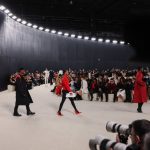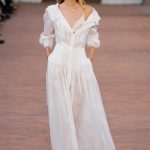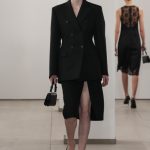Photo: Jacopo Raule/Getty Images
In our long-running series “How I’m Making It,” we talk to people making a living in the fashion and beauty industries about how they broke in and found success.
“I’m my most creative self when I have to be scrappy,” Sami Miro says from Los Angeles, ahead of her first-ever New York Fashion Week runway show.
Since 2016, she’s been building one of today’s buzziest brands, Sami Miro Vintage, which uses deadstock and recycled materials to bring to life pieces in a now-signature deconstructed, form-fitting aesthetic. It’s been worn by the likes of Kendall Jenner, Hailey Bieber, Bella Hadid and Halsey, and is a finalist for the 2023 CFDA/Vogue Fashion Fund. But being a fashion designer was never part of Miro’s plan.
“Fashion, reworking vintage and wearing things my way was a huge part of who I was — it was how I represented myself anywhere I went. It gave me confidence knowing that I was the only person in the world wearing this outfit,” she says. “But even though it was a wildly important part of my life, the idea of monetizing it, there was the world’s biggest blockade that didn’t allow me to think past: ‘I love this, and I feel good when I dress this way.'”
Miro studied marketing in college, and got a masters degree in Global Entrepreneurship and Management before working in tech in San Francisco. Now, her pivot to fashion reaches its peak.
“It wasn’t something that was really planned,” Miro says of the runway show. “The amount of preparation time is probably not ideal for somebody’s first show, but I really get creative enjoyment out of the pressure. I love to learn, and I love to learn by doing…. Although it’s wildly difficult and stressful at times, I will truly be a new person after this experience for the better.”
In addition to running her brand, Miro’s also a model and influencer in her own right, repped by Society Management. Ahead, she discusses the twists and turns her life has taken, from leaving a career in tech to rise through the ranks of fashion to what’s next for Sami Miro Vintage.
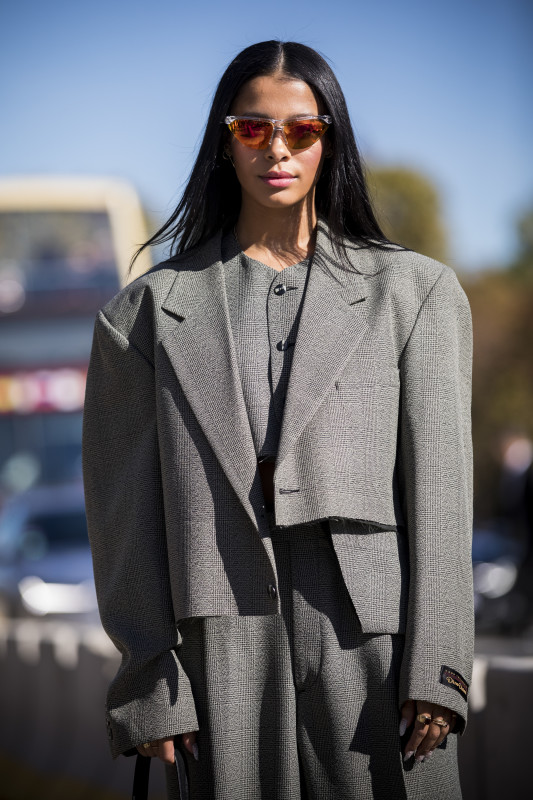
Photo: Claudio Lavenia/Getty Images
What was your relationship with fashion like growing up?
I had my father and an older brother, so I had very little feminine influence around me. There weren’t fashion magazines splayed about, we weren’t watching fashion-y shows and movies — it was very male-centric types of things, like sports.
I think I have a unique relationship with fashion because I see it through a lens that appreciates functionality. I would get my dad’s and older brother’s hand-me-downs — I was a very late bloomer — and instead of just wearing them, I’d think, ‘How can I make it work for my petite body?’ For me, it was just a means to an end. In the very beginning, it wasn’t always a creative thing, where I’m like, ‘Oh, this is an art project.’ It was like, ‘Alright, how do I hide the fact that I might be wearing hand-me-downs and not designer clothes, like the rest of my peers, by making it look like this garment was made for me?’
Like the limited time you have to put on the runway show, that mentality when you were younger sounds like an instance where a constraint forced creativity.
Absolutely. Today, let’s say I’m doing a collaboration with a brand, and I have this big budget that I get to work with that I don’t typically get — I’m still going to take that, say, $100,00 budget and make it look like it was a $2 million budget. It doesn’t matter what it is that I’m working with: Whether it’s $0 or $10,000, I still want to push myself to do something that I haven’t done or that hasn’t done before. I’m never taking the easier route.
What led you to switch careers into fashion?
Even though this probably sounds utterly ridiculous, I was so far removed from the industry that the thought of working in the industry, the thought of being able to monetize my perspective or angle, was not a thought that crossed my mind once, until two years before I started my brand.
I was working at this tech company. I didn’t have to be based in our San Francisco headquarters., so I decided to move to L.A. I pretty much didn’t know anybody, but I quickly met so many people in different types of creative industries that were impressed with my style and wardrobe who encouraged me to get into it.
At that point, I heard about styling for the first time in my life. On the weekends, I would be the coffee runner at a Harper’s Bazaar photo shoot. I didn’t know anything about what brands were out there, what the jobs were on set — I had never had been on a set before. After assisting on maybe two photo shoots, I was like, ‘I can do this.’
For fun, I started styling my friends in my vintage one-of-ones. After six months of that, I was like, ‘Hmm, I think that maybe I could explore designing.’ I knew that if I became a designer, it had to be based around vintage clothing, because that’s the most authentic, me thing out there. Back then, upcycling and reworking vintage weren’t a thing.
I designed this bomber jacket out of all vintage denim, and I had an epiphany: This is what Sami Miro Vintage is. Within 10 days, I designed five pieces; figured out how to manufacture them; found a vintage denim sourcer, a sewer and an embroider; built a website; put together my first photo shoot; did casting; styled the whole thing; reached out to a couple contacts I had in PR and at different magazines; and launched.
What I like to do is teach myself, figure everything out in real time versus do a bunch of research and see how other people did it. I had no exposure to photo shoots and sets in fashion (before freelancing) — I needed just like two times to understand what was going on, and then I was like, ‘That’s all I need. Let me just try this myself.’
What experiences helped you launch Sami Miro Vintage?
The first would be my first experience on set ever. My friend Dylan Penn was shooting an editorial, and I had expressed my interest in understanding what styling was. She was like, ‘Come on set with me.’ I was a bystander, watching the whole time, absorbing what she was doing, how she was behaving, how many looks there were, what the stylist was like, what the rack of clothing was, how many assistants she had…
That day, I told her, ‘How do I talk to the stylist and see if maybe she’ll let me assist her?’ I was too scared to talk to the stylist, so, I talked to the stylist’s assistant, who felt much more approachable. The next day, she had me as her assistant, so I was the assistant’s assistant. That was my first fashion job and one of the big milestones, since it was my first exposure to that world and my first connection in styling.
One of my best friends is Marc Griffin, a singer known as Marc E. Bassy, who’s also from San Francisco. He recognized the uniqueness of my attire and capabilities before I moved to L.A., and he was the first person to ever encourage me to think about something in fashion. I just didn’t know what any of the jobs were. He actually bought me a sewing machine. That was the very first awakening.
What did it feel like to get that sewing machine and dive into something completely new?
I had never used one before. It was a very thoughtful gift, but one I had to then figure out. It sat around for a little bit, but when I moved to L.A. soon after, I took some sewing classes at Mood. I started sewing lingerie out of elastic straps — that was the first thing I ever designed and created.
How has Sami Miro Vintage evolved since your first collection?
It has evolved tremendously in so many ways, from my skill level to my confidence. I always had a very strong perspective and ethos that was rooted in ethical, local production, in eco-consciousness, in educating people about the planet and thinking differently when it comes to fashion or a variety of industries. That part hasn’t changed. If anything, it’s just gotten stronger.
What have you learned along the journey?
Maintaining that ethical ethos. Building and growing a team. Learning how to manage people and different personalities, how to develop as a boss, how to mentor… It started off with me and only me. Now, they’re still my decisions and my designs, but I have a wonderful team around me, and everybody has their own needs — it’s about figuring out how to incorporate that into your day.
Taking it back, we all experience situations in life where we have an option of pursuing something that might not be what everybody else wants us to do or has a vision of us doing. Taking that leap into the unknown is one of the most frightening things that you can do. Everybody might think you’re crazy, but for me, if I hadn’t done that very risky thing, I would’ve regretted it for the rest of my life. I always knew that if it didn’t work out, I could go back to marketing, to the corporate world, and that would be it.
What have been some of your biggest achievements so far?
I was inducted into the CFDA as an interim member in 2022. That was huge for me because of my background, because I’m so non-traditional in the fashion world. Fashion, along with many industries, can be very archaic, and I’m all about doing things differently, in my way. It was never even on my radar to be acknowledged by the CFDA because I wasn’t on the fashion calendar or having runway shows or doing things that were ‘supposed to be done.’ That was huge for me, to know that the world of fashion saw me. Being one of the finalists in the CFDA/Vogue Fashion Fund this year is so major.
I did a collaboration with Levi’s last year, and that was a major full-circle moment because my first canvas as a designer was vintage denim. All of my pieces when I first launched were vintage denim. That continues to be a throughline for me… Whether scraps or full jeans, it’s always been Levi’s.
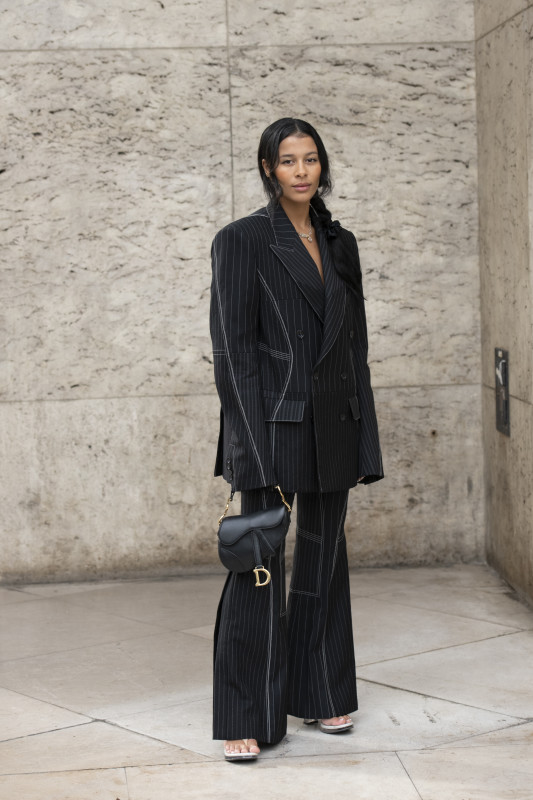
Photo: Kirstin Sinclair/Getty Images
What’s next for Sami Miro Vintage?
The next thing that I really want to get ahead of and lead in is zero waste. That’s naturally how I’ve always designed, because for me, I see tremendous beauty in scraps. Let’s say I’m reworking a pleather jacket, and a scrap falls on the floor — I look at that scrap, and it speaks to me; the shape that it has since it’s been cut, maybe there are details on it that are unique, maybe the lining is showing in a way that I would have never seen before. I look to the fallen pieces for inspiration. That’s an element of what zero waste is all about, ensuring that everything has a place… You have to design and cut in a more creative way, because you have limitations.
What do you think will be on the other side of your first runway show?
To put it into perspective, I decided to do this runway show about a month (before), so I had to figure out the creative, the location, the team, the PR, the production, the casting, the hair, the makeup, the styling… then also design the collection. It’s a whole beast that I’ve never done before. I’ll definitely know how to do it with my eyes closed if it happens again.
Then, there’s the uncomfortable part: pitching for sponsorship. Runways are very expensive. A last-minute decision of doing a runway show wouldn’t be financially responsible for me to fund it. Money is not something that I’ve loved to talk about — I have my CEO, who does all of the money conversations — but for this, I made the sponsorship deck. I’m the one pitching it out. Although doing this within a one-month period has been wild, while having the day-to-day business, I’m so happy. I feel I have changed as an entrepreneur, as a company owner. I feel a lot more confident in the area that I was lacking confidence.
This interview has been edited and condensed for clarity.
Want the latest fashion industry news first? Sign up for our daily newsletter.

